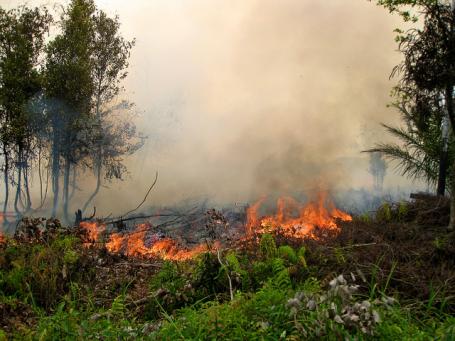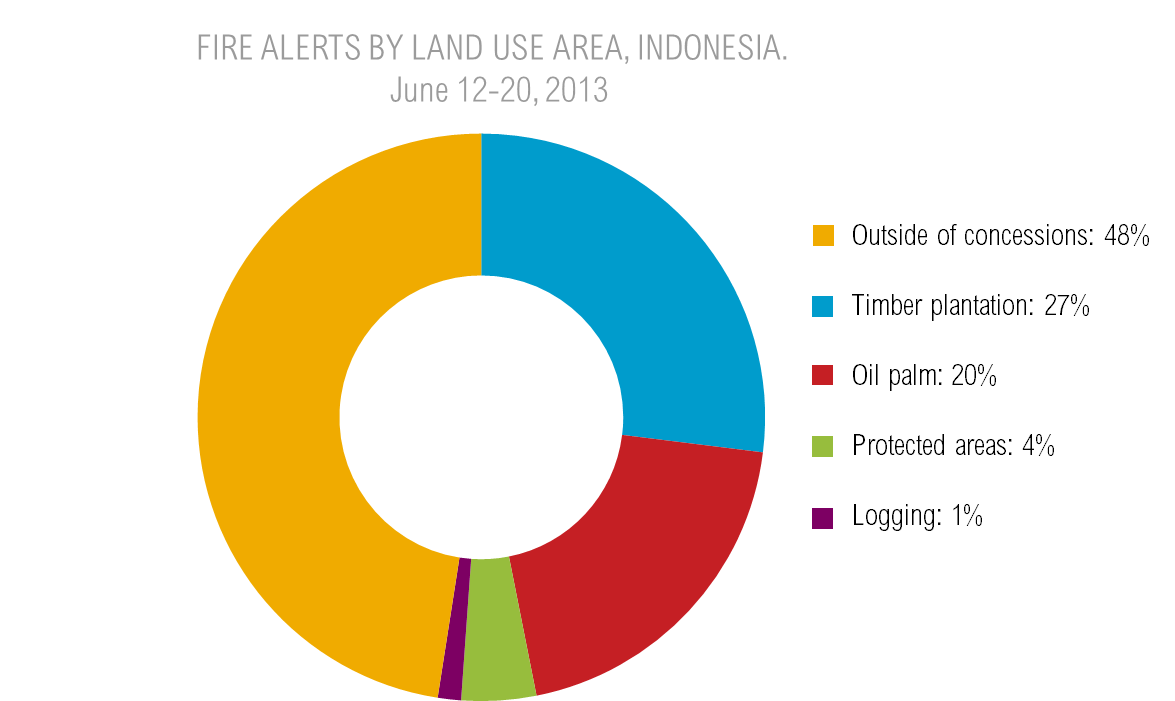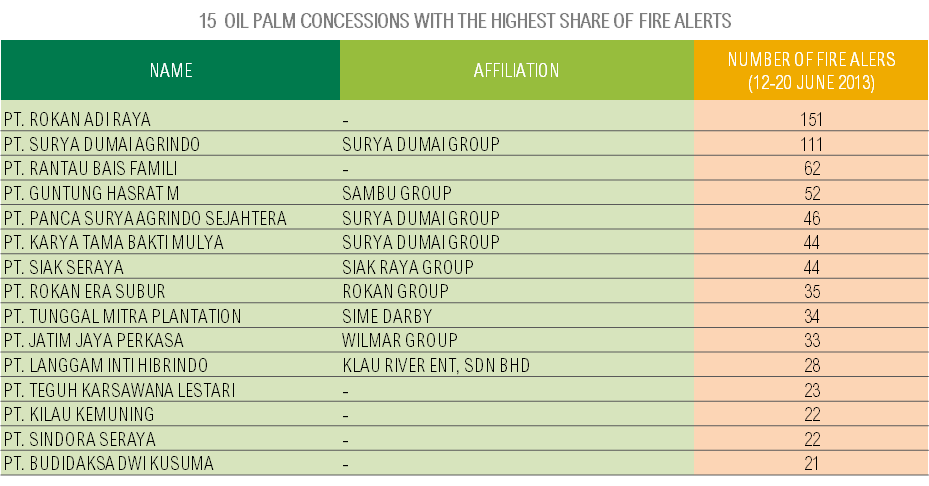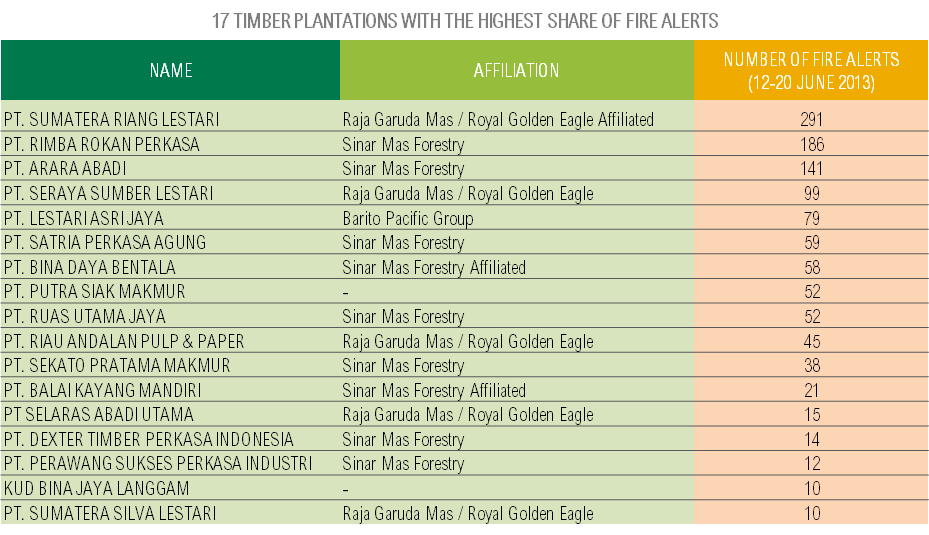Peering Through the Haze: What Data Can Tell Us About the Fires in Indonesia

WRI has released updated data on the fires in Indonesia. Read the story here or see updated, real-time fire data on the new Global Forest Watch-Fires platform.
Cecelia Song, Andrew Leach, and other experts at WRI also contributed to this post.
People in Indonesia, Singapore, and parts of Malaysia are currently suffering from debilitating levels of haze resulting from forest fires. Air quality levels in Singapore have deteriorated to the worst levels ever recorded on the island, while local airports in Indonesia and some schools in Malaysia have had to close. Almost all of the recent fires (June 12-20) have occurred in Sumatra, an island in western Indonesia.
While there’s been heated debate on the location, cause, and nature of the fires, WRI has compiled some initial data that reveals that there are some patterns. Relatively few fires have occurred in protected areas and selective logging concessions. Furthermore, half of the fires are burning on timber and oil palm plantations. Although it is illegal for companies in Indonesia to start forest or land fires, several companies have used fires for land clearing in the past. It will be important to gather more detailed information about the exact location of the fires and their causes, which could have important implications for the companies and government agencies involved.
A Look Inside the Forest Fire Data
WRI gathered information from NASA’s Active Fire Data, which uses satellite data to pinpoint the location of fires in near real time, together with the Indonesian Ministry of Forestry’s concession maps for oil palm, logging concessions, and timber plantation licenses. We counted the number of NASA fire alerts in each concession in Indonesia and tabulated the results.
NOTE: The visualizations below are based on publicly available data from NASA and the Government of Indonesia. WRI experts have done their best to verify this information, but cannot confirm the accuracy of the original information.
Explore WRI’s full-screen interactive map of the forest fires and concessions.
While this is a preliminary snapshot, we can note some interesting trends:
Inside the Data
The information in this post draws on two data sets:
- NASA's real-time Active Fire Data from the Fire Information for Resource Management Systems (FIRMS) for the dates June 12-20, 2013. For detailed information about how the Active Fire Data works, see this FAQ page from NASA.
- Concession maps for oil palm, logging concessions, and forestry plantation licenses, dated 2010, from the Indonesian Ministry of Forestry, which we had previously downloaded from the Ministry’s website. (Note that this information is not currently available on the Ministry website.)
-
Most of the NASA fire alerts are located within the province of Riau, and chiefly within the boundaries of timber plantation and oil palm concessions. About 52 percent of the total fires occur within these concession areas. (See more information at the end of this post.) Far fewer fire alerts are located in protected forests or in concessions for selective logging.
-
According to available official data, companies that are part of the Sinar Mas and Raja Garuda Mas (RGM) groups own the concessions licenses where the largest numbers of fire alerts are found. Together, these two groups account for more than 50 percent of the fires across all concessions.
-
It will be important for government agencies to conduct further investigations and verify the location and direct causes of the fires. Satellite data can show the location of the fires, but does not indicate how they started or spread. It is also in the public interest to have up-to-date and publicly available concession data.
Better management of forest resources is one of the keys to preventing future fires. By improving near-real-time detection of change, government agencies, companies, and communities can coordinate and respond quickly to fire events. Satellite mapping and data tools—such as WRI’s Forest Cover Analyzer—can help to visualize forest clearing, fires, and concession data. Later this year, WRI and its partners will be launching Global Forest Watch to help better understand forest clearing at a global scale.
With better data, governments and companies in Indonesia can make better decisions—and move towards a future with clearer skies.
LEARN MORE: For more WRI analysis on Indonesia's fires, check out our blog series.
WRI used NASA’s Active Fire Data to determine the likely location of fires on the ground. This system uses the NASA MODIS satellites that survey the entire earth every 1-2 days. The sensors on these satellites detect the heat signatures of fires within the infrared spectral band. When the satellite imagery is processed, an algorithm searches for fire-like signatures. When a fire is detected, the system indicates the 1 km2 where the fire occurred with an “alert.” The system will nearly always detect fires of 1,000 m2 in size, but under ideal conditions, can detect flaming fires as small as 50 m2. Since each satellite passes over the equator twice a day, these alerts can be provided in near-real time. Fire alerts are posted on the NASA FIRMS website within 3 hours of detection by the satellite.
The accuracy of fire detection has improved greatly since fire detection systems were first developed for the MODIS satellites. Today, the rate of false positives is 1/10 to 1/1000 what it was under earlier systems first developed in the early 2000s. The algorithm used to detect fires includes steps to eliminate sources of false positives from sun glint, water glint, hot desert environments and others. When the system does not have enough information to detect a fire conclusively, the fire alert is discarded. In general, night observations have higher accuracy than daytime observations. Desert ecosystems have the highest rate of false positives. Many papers have been published to validate the NASA MODIS active fire alerts for use in various applications. WRI is employing a recommendation for detecting forest clearing fires (described in Morton and Defries, 2008), identifying fires with a Brightness value ≥330 Kelvin and a Confidence value ≥ 30% to indicate fires that have a high confidence for being forest-clearing fires. Low confidence fires are lower intensity fires that could either be from non-forest-clearing fire activity (clearing fields or grass burning), or could be older fires that have decreased in intensity (smoldering rather than flaming fires). The use of this classification establishes a higher standard for fire detection than using all fire alerts equally.
Sources: NASA FIRMS FAQ Morton, D., R. DeFries, J. T. Randerson, L. Giglio, W. Schroeder, and G. van der Werf. 2008. Agricultural intensification increases deforestation fire activity in Amazonia. Global Change Biology 14:2262-2276.


